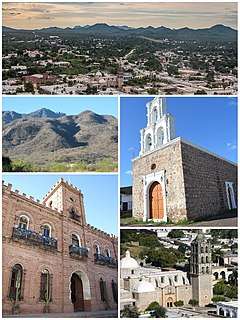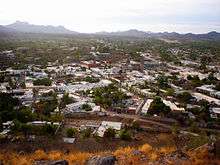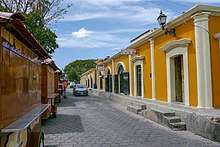Álamos
Álamos (Spanish: ['alamos] (![]()
Álamos, Sonora | |
|---|---|
 Top, from left to right: Panoramic view of Álamos, Chapel of Zapopan, Semi-arid municipality landscape, City Hall, Cathedral of Purísima Concepción | |
 Coat of arms | |
 Álamos, Sonora Location in Mexico  Álamos, Sonora Álamos, Sonora (Mexico) | |
| Coordinates: 27°1′39″N 108°56′24″W | |
| Country | |
| State | Sonora |
| Municipality | Álamos |
| Founded | Late 17th century |
| Population (2005[1]) | |
| • Total | 24,493 |
| Time zone | UTC-7 (MST) |
| Postal code | 85760 |
| Area code(s) | 647 |



Name
The Municipality of Álamos derives its name from the álamo ("poplar") tree. Several impressive specimens are found in one of its two principal plazas, the Alameda. The nearby hamlet, El Sabinito, located within the municipality, also derives its name from a tree, the sabino ("Montezuma cypress").
History
The area was named by the conquistador Francisco Vásquez de Coronado. His expedition of 1540 camped at the confluence of the two major arroyos (Escondido and the Aduana) of present-day Álamos and made reference to local geographical landmarks, including two large rock formations on Mount Alamos known as Los Frailes, 'the monks' in English.
As historian David Leighton explained, “Its first known name was Real de los Frailes or “Mining Camp of the Friars,” a designation taken from some tall white rocks that appeared like hooded monks near the village.”[2]
The church records of Álamos date to 1682, but it was founded on December 8, 1685, by the Spanish soldier, Domingo Terán de los Ríos, after the discovery of the silver mines at Promontorios, La Aduana, Las Cabras, La Quintera, and others of lesser importance nearby.[3] Rios in 1686 became governor of Sonora and Sinaloa, where he was successful in quelling Indian disturbances.[4]
A major expedition led by Juan Bautista de Anza II departed Álamos in 1775 to discover a route to Alta California. The Anza expedition had nearly 300 members, of which about half were from Álamos. The trek was financed by the wealthy silver mine owners of Álamos, and it established the Presidio of Monterey.
Álamos became the capital of what was then the state of Occidental in the early 1800s. Occidental encompassed today's state of Sonora, the northern portion of the state of Sinaloa, and some of Baja California and southern Arizona. Álamos was the northernmost “Silver City” in Mexico. While it has much in common, architecturally, with Mexico's other “Silver Cities,” Álamos has not succumbed to large-scale commercialism and has managed to retain the charm and pace of earlier times.
Álamos is known as “La Ciudad de los Portales” (portales are tall, arched, covered verandas or walkways fronting many of the cobble-stoned streets or calles). Álamos boasts numerous buildings exhibiting classic Andalusian architecture from Mexico's Colonial period, including numerous mansions, the Plaza de Armas, the Church of La Purísima Concepción, La Capilla and the Palacio Municipal (“city hall”).
The great wealth created by the silver mines from the surrounding mining towns of La Aduana, Minas Nuevas, and others enabled the founders and residents of Álamos to build scores of colonial Spanish mansions throughout the town; most of them went into ruin in the early 20th century but in the late 1940s, a number of Americans and Canadians began buying and restoring the houses.
By 1955, the city had electricity running from dusk to about midnight and in 1960 electrical power began to run 24 hours a day, being generated at a dam on a nearby river.
In the 1980s, a study was done by the students at the University of Sinaloa, which caused in 185 structures in town being listed as historic monuments.
Geography and climate
Álamos is located in the southeastern part of Sonora, and 396 km (246 mi) from state capital Hermosillo, 54 km (34 mi) from Navojoa via Sonora State Highway 162, and 663 km (412 mi) from the northern border town of Nogales. The State of Chihuahua is on the east, and the State of Sinaloa on the south. The population of the municipality is 24,493 and its area is 6,947.27 square kilometres or 2,682 square miles.
Álamos has a semi-arid climate (Köppen BSh) bordering on a tropical savanna climate, with three seasons: a hot, dry season from April to June, a hot, humid wet season from July to October, and a warm, generally dry “winter” from November to March. Occasionally the dry winter pattern is interrupted by the passage of frontal cloudbands: 220 millimetres (8.66 in) fell during January 1981, including 168 millimetres (6.61 in) between the fifth and the seventh of that month, and over 120 millimetres (4.72 in) in January 1979.[5] During the hot early summer, temperatures can reach extreme heights; the record being 49.5 °C (121.1 °F) on 16 June 1976.
| Climate data for Álamos (1951-2010) | |||||||||||||
|---|---|---|---|---|---|---|---|---|---|---|---|---|---|
| Month | Jan | Feb | Mar | Apr | May | Jun | Jul | Aug | Sep | Oct | Nov | Dec | Year |
| Record high °C (°F) | 41.5 (106.7) |
44.0 (111.2) |
44.0 (111.2) |
43.0 (109.4) |
48.0 (118.4) |
49.5 (121.1) |
45.5 (113.9) |
44.0 (111.2) |
46.0 (114.8) |
43.0 (109.4) |
39.0 (102.2) |
39.0 (102.2) |
49.5 (121.1) |
| Average high °C (°F) | 27.8 (82.0) |
28.8 (83.8) |
30.2 (86.4) |
32.5 (90.5) |
35.2 (95.4) |
38.0 (100.4) |
36.2 (97.2) |
35.1 (95.2) |
35.2 (95.4) |
34.4 (93.9) |
31.7 (89.1) |
28.6 (83.5) |
32.8 (91.0) |
| Average low °C (°F) | 9.2 (48.6) |
9.5 (49.1) |
10.2 (50.4) |
11.6 (52.9) |
14.1 (57.4) |
18.2 (64.8) |
19.8 (67.6) |
20.1 (68.2) |
18.4 (65.1) |
15.2 (59.4) |
11.5 (52.7) |
9.5 (49.1) |
13.9 (57.0) |
| Record low °C (°F) | 0.0 (32.0) |
−4 (25) |
2.0 (35.6) |
5.0 (41.0) |
6.5 (43.7) |
8.0 (46.4) |
9.0 (48.2) |
9.5 (49.1) |
1.3 (34.3) |
6.5 (43.7) |
0.4 (32.7) |
0.0 (32.0) |
−4 (25) |
| Average rainfall mm (inches) | 35.0 (1.38) |
17.9 (0.70) |
17.8 (0.70) |
1.9 (0.07) |
3.9 (0.15) |
25.5 (1.00) |
184.4 (7.26) |
198.2 (7.80) |
86.3 (3.40) |
53.1 (2.09) |
26.3 (1.04) |
37.0 (1.46) |
687.3 (27.05) |
| Average rainy days (≥ 0.1 mm) | 2.4 | 1.4 | 1.2 | 0.3 | 0.4 | 2.2 | 12.8 | 11.0 | 6.8 | 3.1 | 1.6 | 2.2 | 45.4 |
| Source: Servicio Meteorólogico Nacional[6] | |||||||||||||
Economy
After a heyday lasting from the late 1600s until the early 1900s, when the silver mines closed, the economy of Alamos went into a serious decline. Only a few hundred people remained in the once vibrant city due to a major decline in silver prices, ongoing unrest in the country with a revolution in progress, and the exodus of business owners and people of wealth. Vacant mansions went into disrepair until foreigners began restoring homes in 1946 after three decades of abandonment, bringing employment to locals with building and housekeeping skills. The area's top industries for decades were ranching and tourism. The present-day economy includes copper and silver mines. About 16 km to the northwest is the Adolfo Ruiz Cortinez Dam and Reservoir known as “El Mocúzarit”, whose waters irrigate 80,000 acres (320 km2). Cattle ranching is seasonal and declining due to impoverished grazing lands. Numerous chicken and pig farms, called “granjas,” contribute substantially to the economy.
Tourism
Álamos was named a “Pueblo Mágico” in 2005. “Pueblo Magico” is a designation given by the Mexican Secretariat of Tourism to towns that offer a 'magical' experience by reason of their natural beauty, cultural riches and historical relevance.
Álamos has many festivals and fiestas year-round. Most notable is the Festival of Dr. Alfonso Ortiz Tirado (“FAOT”), attended by many national and international musicians and celebrities. Dr. Alfonso Ortiz Tirado, born in this community in 1894, achieved recognition for being “El Tenor de las Américas.” An impressive exhibit of Ortiz Tirado is found in the Museo Costumbrista, located in front of and to the east of the Plaza de Armas. The annual Festival Alfonso Ortiz Tirado is a nine-day event that takes places in Álamos annually in late January. The annual film festival is usually held in March. Several professional hunting lodges operate in the Alamos area, attracting dove hunters from various areas of the world. Álamos has more recently been the location for film production, including a European Endemol production and more than 180 episodes of the 'novela' (soap opera) 'La Fuerza del Destino'.
The Sierra de Álamos Ecological Reserve offers serious “birding” opportunities. The creek of Cuchujaqui, which is in the ecological reserve is the most species-rich subtropical area in the Northern Hemisphere. Cuchujaqui is the subject of international scientific study and the southern migration destination of hundreds of different species of birds.
The presence of a jet-rated airport in Alamos (XALA) attracts aviators from Mexico, the U.S. and Canada. There is also charter service available to some areas of the Copper Canyon. The village has more than 20 hotels and B&B's.
Notable residents
- María Félix, film actress
- Gloria Fonda, silent film actress (died in Álamos in 1978)
- Arturo Márquez, composer
- Alfonso Ortiz Tirado, physician, tenor, and philanthropist
- Félix María Zuloaga, former President of Mexico
Carroll O’Conner, actor (best known for his role as Archie Bunker in the sitcom "All in the Family")
- Geraldine Page, oscar-winning actress
- Rip Torn, emmy-winning actor
Sister cities
Planet Mars
The name Álamos has been used for a crater on the planet Mars by the International Astronomical Union, although not specifically commemorating the town.[7]
References
- (in Spanish) 2005 census Archived 2011-06-13 at the Wayback Machine, INEGI.
- David Leighton, “Street Smarts: Los Portales was Ray Manley’s homage to lovely Alamos, Sonora,” Arizona Daily Star, Sept. 2, 2019
- Álamos (Sonora) from es.wikipedia.org accessed October 27, 2018.
- Robert Bruce Blake, "TERAN DE LOS RIOS, DOMINGO", from tshaonline.org, Handbook of Texas Online, accessed October 27, 2018.
- Servicio Meteorólogico Nacional; CLIMATOLOGÍA ESTADÍSTICA: Álamos
- "ESTACION: 00026002 ALAMOS". Servicio Meteorólogico Nacional. 2012. Retrieved on May 12, 2015.
- Categories for Naming Features on Planets and Satellites, Gazetteer of Planetary Nomenclature, USGS Astrogeology Science Center, NASA
External links
| Wikivoyage has a travel guide for Álamos. |
- H. Ayuntamiento de Álamos (Official WebSite of Álamos, Sonora)
- Turismo Sonora
- Álamos Sonora Mexico ©2010 – 2018 Anders Tomlinson, all rights reserved.
- Álamos Sonora Mexico Expatriate Community Forum
| Wikimedia Commons has media related to Álamos, Sonora. |